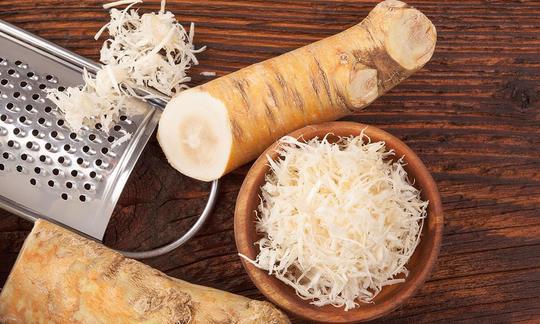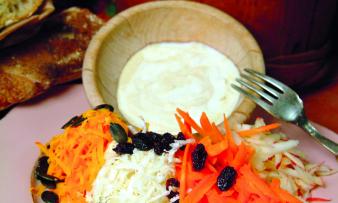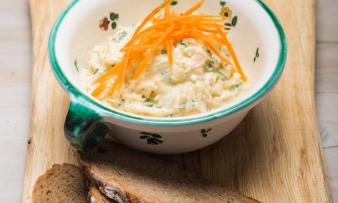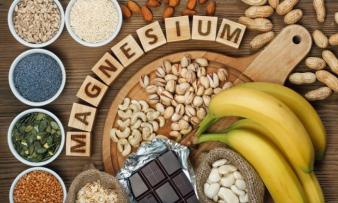Table of contents
Horseradish ( Armoracia rusticana) , also Horseradish is best enjoyed raw and freshly grated. Its spiciness comes out particularly well in sauces or dips.
Use in the kitchen
Can you eat horseradish raw? It is best to eat horseradish root raw. This brings out the typical sharp taste and pungent smell best. If you heat the horseradish, you destroy the heat-sensitive vitamins and mustard oils, which changes the taste.
Do you have to peel horseradish? After washing, the skin should be peeled off with a sharp kitchen knife or vegetable peeler, as the outer layer can taste a little bitter and its fibrous structure makes grating difficult. There may also be harvest residue on the skin, which can be removed by peeling. After grating with a kitchen grater, a little lemon juice or vinegar helps to preserve the white color. As the essential oils evaporate quickly, the grated root should be processed or enjoyed as quickly as possible. Grated horseradish tastes good as a seasoning in sauces, dips and with dishes that can tolerate a little spiciness.
Horseradish is well known in combination with beetroot , in salads or in soups. A pure horseradish soup is best thickened with potatoes and refined with vegan sour cream .
A vegan horseradish spread tastes great with apple or rice as the base ingredient, and you can also find recipes with cashew nuts as a base. Try the healthier walnuts .
Horseradish is also suitable for refining salads, e.g. potato salad or in a salad dressing . Or you can try the vegan sauerkraut salad with carrot and apple .
Horseradish tastes great with vegan salmon, which is based on carrots . Wholemeal bread, capers and onions complement the dish.
Horseradish leaves can also be eaten raw and used in raw food recipes, e.g. as vegan pesto made from horseradish leaves. Cooked, they taste great as spinach or with oven-baked vegetables.
Vegan recipe for lamb’s lettuce with horseradish
Ingredients (for 2 people): 2 beetroot (cooked), 125 g lamb's lettuce (raw, organic), 50 g walnuts (raw, organic), 2 tbsp grated horseradish root (raw, organic), 50 g tofu (organic), 2 tbsp soy sauce (organic), 4 tbsp apple cider vinegar (organic), 4 tbsp walnut oil (organic), 1 tsp mustard (organic), 1 tbsp honey (organic), salt ,pepper .
Preparation: Cut the tofu into small cubes, fry until golden brown and deglaze with soy sauce. When the tofu has completely absorbed the soy sauce, put it to one side. Now peel the cooked beetroot and slice it into thin slices. Put the apple cider vinegar, walnut oil, mustard, honey, salt and pepper in a small screw-top jar and shake well. Arrange the beetroot with the lamb's lettuce and sprinkle finely grated horseradish on top. Finally, garnish with walnuts, tofu cubes and dressing.
Vegan recipes with horseradish can be found under the note: " Recipes that have the most of this ingredient ".
| Not only vegans or vegetarians should read this: Vegans often eat unhealthily. Avoidable nutritional mistakes . |
Purchasing - Storage
Horseradish is in season from October to January . You can then find it in major retailers such as Coop , Migros , Denner , Volg , Spar , Aldi , Lidl , Rewe , Edeka , Hofer, Billa or in organic markets ( Denn's Biomarkt , Alnatura ). Seasonal organic boxes and weekly markets also have horseradish in their range during the season.
Prefer unpackaged, fresh horseradish from organic farming. Although horseradish in jars is available all year round, it usually contains oil ( rapeseed oil ), table salt , citric acid, potassium metabisulfite, sulfur dioxide, sulfites and other additives.
The availability of horseradish varies depending on the size of the store, catchment area, etc. If you are interested, click on our recorded food prices for the DA-CH countries (above under the ingredient image). There you will find current prices from various supermarkets and their price development.
Found in the wild
Horseradish can be found in the wild (wild horseradish) in Europe and Asia in damp meadows, near streams and rivers. 12 All parts of the horseradish are edible. The leaves can be harvested from March to May and the roots from September to winter.
Storage tips
To store it, the fresh root should be cleaned. Wrapped in paper and stored in the vegetable compartment of the refrigerator, it will keep for up to four weeks. You can also freeze the grated root. 13
Ingredients - Nutritional values - Calories
100 g of horseradish has 78 kcal. The root consists of 75% water and contains hardly any fat, 19 g/100g carbohydrates and 2.5g/100g protein. 1
Horseradish contains a lot of magnesium, at 628 mg/100g. This amounts to 167% of the daily requirement if you eat 100g. Wheat bran has similar values, and unpeeled hemp seeds have a little more, at 700 mg/100g. 1
The vitamin C content is very high at 114 mg/100g. 100g therefore provides 143% of the daily requirement. However, people rarely eat 100g of horseradish. A more realistic measure is a tablespoon (15g) of horseradish. This amount contains around 17mg of vitamin C, which still corresponds to 21% of the daily requirement. The value per 100g is comparable to that of sorrel or kale . Garlic mustard has even more vitamin C (261 mg/100g). 1
Horseradish also contains significant amounts of potassium : 628 mg/100g make up 31% of the daily requirement. Comparable to tamarind or Mexican goosefoot . Unpeeled hemp seeds have much more at 1200 mg/100g. 1
You can find all the ingredients of horseradish, how much it covers your daily needs and comparison values with other ingredients in our nutrient tables below the ingredient image.
Effects on health
Is horseradish healthy? Horseradish contains many ingredients, especially secondary plant ingredients, which are considered healthy. Glucosinolates, also known as mustard oil glycosides, are nitrogen and sulphur-containing chemical compounds that occur in all cruciferous vegetables (e.g. broccoli , radish , cabbage , mustard and radishes ). Glucosinolates are actually odourless. If the root is cut or damaged (by predators), the enzyme myrosinase converts the glucosinolates into volatile, sharp-tasting mustard oils. 5 This reduces their effect, which is why horseradish should not be dried but enjoyed fresh. 2 This conversion (hydrolysis) produces isothiocyanates, among other things. 17
The active ingredients of the root are 0.2 to 0.6% mustard oil glycosides (mainly sinigrin and gluconasturtiin), which stimulate the gastric juice of bile acid and thus the appetite. In addition to an antispasmodic effect on the muscles, the glucosinolates contained also have anti-inflammatory and immune-stimulating properties. The antimicrobial effects on various gram-negative and gram-positive germs, as well as yeasts ( Candida albicans ) 2 are attributed specifically to the isothiocyanates. Specifically, they were effective in vitro against human pathogens such as Escherichia coli, Listeria monocytogenes, Salmonella typhimurium, Sthaphylocossus aureus and Vibrio parahaemolyticus . This study also demonstrated antioxidant mechanisms of action. 8
The antibacterial properties of isothiocyanates are also associated with an anti-cancer effect. Bacteria often cause the development of certain types of cancer, for example Helicobacter pylori is suspected to be responsible for stomach cancer. 10 In addition to cancer-preventing mechanisms, isothiocyanates are also believed to be able to eliminate established cancer cells 17 . by blocking the cell cycle and promoting apoptosis (programmed cell death). 14
In addition to the anti-inflammatory, antibacterial, antifungal, antioxidant and anti-cancer effects mentioned above, sinigrin in particular is also said to heal wounds. Such studies work with isolated forms and extracts of these biological compounds. More specific research on the therapeutic application of these agents is still required. 9
The isothiocyanates produced by hydrolysis of glucosinolates are mostly beneficial to health - but not all of them. The protective effects of a diet rich in fruits and vegetables against oxidative stress, carcinogenesis and associated diseases are probably not due to a specific substance. It is possible that a variety of ingredients have an overall positive effect on health, even if they contain other compounds that may have harmful effects. 16
Dangers - Intolerances - Side effects
The mustard oil isothiocyanate from the horseradish root can have a toxic effect in undiluted form. Even as a spice, one should not consume more than 20 g of the root daily. Allergic reactions can occur in isolated cases. 11
The spiciness of horseradish has an irritating effect on the mucous membranes. Therefore, its use as a medicinal plant should not last longer than 4 to 6 weeks. 2 It is contraindicated, i.e. not recommended, for use in children under four years of age, in cases of gastrointestinal ulcers and kidney inflammation. 18
Use as a recognized medicinal plant
Commission E recognizes horseradish root as a medicinal plant and recommends its use for: Catarrh (inflammation) of the upper respiratory tract as a finished medicinal product or freshly pressed plant juice. Horseradish in combination with nasturtium herb also helps with inflammation of the urinary tract (urinary tract infections). External application has also proven effective for mild muscle pain due to its hyperemic (warming, circulation-stimulating) effect. Use as a tea infusion is not recommended. 18
Folk medicine - natural medicine
Horseradish has a long tradition as a spice and medicinal plant 15 and is still used today, especially in Eastern Europe and Russia. 14 Due to its effectiveness against many complaints such as headaches, bronchitis, coughs, 15 sinusitis, cystitis, periodontitis, rheumatism, anemia, gastritis, pain relief for sciatica, inflammation of the skin, wound healing and scurvy, 14 it was called the 'peasant's penicillin'. 7
It is also used for chest and stomach pain, digestive problems, flatulence, persistent coughs, snake bites, fungal poisoning, inflammation of the throat and mouth, mouth rot, otitis (inflammation of the outer skin of the ear canal), hematomas, dropsy and jaundice, liver and bile duct diseases, muscle pain, gout and toothache. 2
Ecological footprint - animal welfare
As horseradish is a very undemanding plant with low demands on its environment, it can be cultivated in many regions of Europe. This means that transport distances are very short and the ecological footprint is also is low. There are hardly any concrete figures for the CO 2 footprint of horseradish.
To make your garden or balcony more ecological and diverse, you can also grow horseradish yourself. However, it should be remembered that horseradish spreads quickly in the garden or landscape, can become invasive and is difficult to remove. To avoid this scenario, you can grow horseradish plants in a container or raised bed to limit or more easily control its growth. Here, the plant provides a food source for bees, can increase insect and pollinator diversity, and recycle nutrients. 14
Worldwide occurrence - cultivation
Horseradish has been cultivated in Western Asia for over 2000 years and in Eastern Europe for less than 2000 years. 3 Today the plant is cultivated worldwide.
Cultivation - Harvest
Horseradish is a very decorative plant with dark green, lanceolate leaves up to 1.5 m long. They have a toothed to strongly notched edge. The fragrant, four-leafed, white flowers of the horseradish appear from May to July. The fruits develop from these; spherical to egg-shaped pods filled with smooth seeds. Horseradish is winter hardy to -50 °C. The strong taproot can reach up to 50 cm. 2 In cooler regions, horseradish needs little care; it grows best in full sun or partial shade. Although horseradish thrives in almost any soil, it needs permeable soil for optimal growth. The drought-tolerant plant has few pests 7 and is very hardy. Glucosinolates protect the plant from being eaten - but some insects, such as the cabbage white butterfly or cabbage aphid, have adapted to the mustard oil and perceive it as a feeding incentive. 2
Horseradish can be grown in a pot on the balcony or as a permanent vegetable in the garden. If you want to produce particularly straight, long horseradish sticks, you can create a raised bed for planting. Between April and May, plant the 30-40 cm long and about 1 cm thick root ends (side shoots of the roots) at a 30 degree angle, 30 cm apart. When harvesting the main root in late autumn, remove the side shoots and store them in moist sand until the next gardening season in spring. 6
In commercial cultivation, horseradish roots are harvested in October and November after the leaves have died. 4 However, harvesting is possible until January, provided the ground is frost-free.
Further information
Horseradish belongs to the cruciferous family (Brassicaceae) and to the genus Amoracia , the three best known species of which are A. rusticana, A. macrocarpa and A. sisymbrioides .
Wasabi ( Eutrema japonicum ) , known as Japanese horseradish (water horseradish), is also a cruciferous vegetable and is a very popular, spicy spice in Japanese cuisine.
Alternative names
In German-speaking countries, horseradish is also called Scharfwurzel, Beisswurzel, Bauernsenf, Chren, Fleischkraut, Kren, Koren, Krien, Pfefferwurzel, Pferderettich or Waldrettich. In English, it is called horseradish.
The medicinal drug made from horseradish root is called Armoraciae radix.
Latin synonyms for Armoracia rusticana are A. lapathifolia or Cochlearia armoracia .
Other uses
Horseradish is also used in organic farming, as a so-called biofumigation (fungicide, pesticide). 9 ,15
Horseradish peroxidase is used in biotechnological analysis. 10










Comments